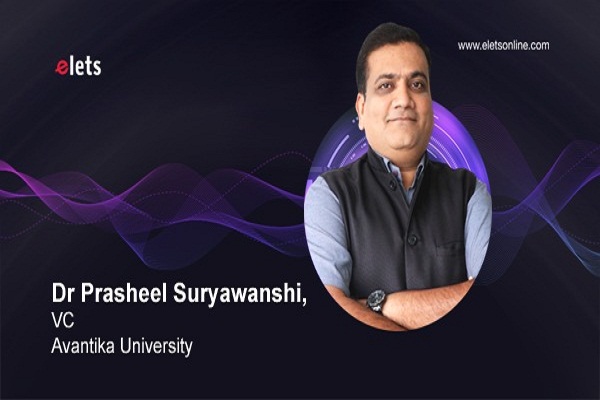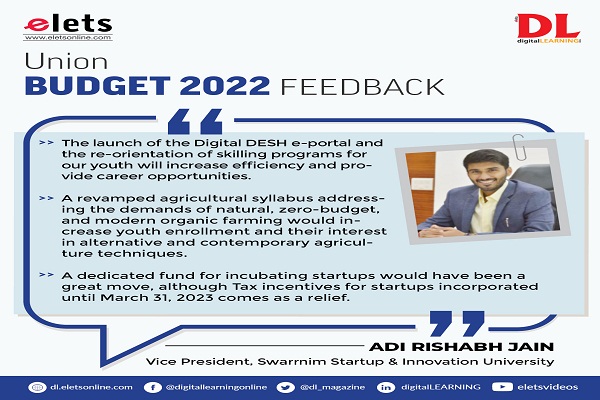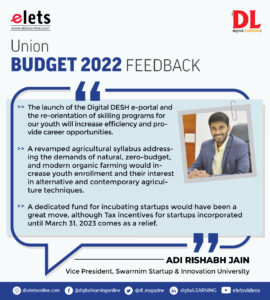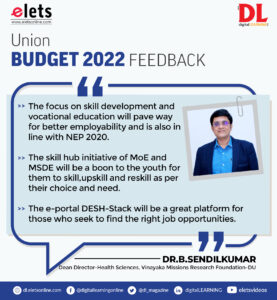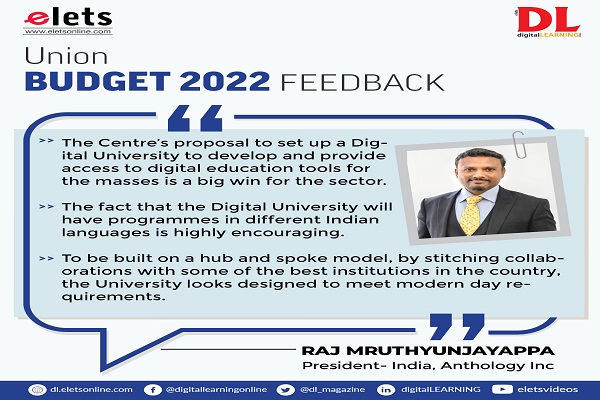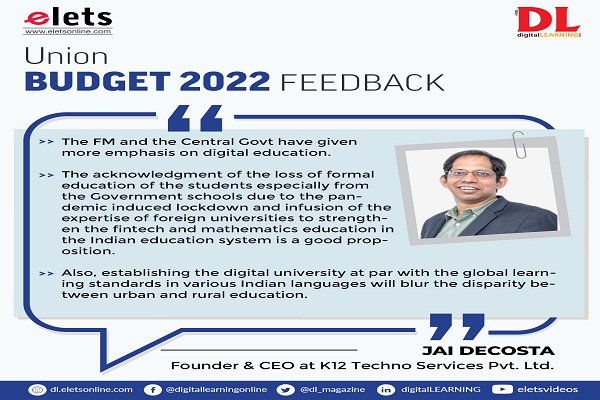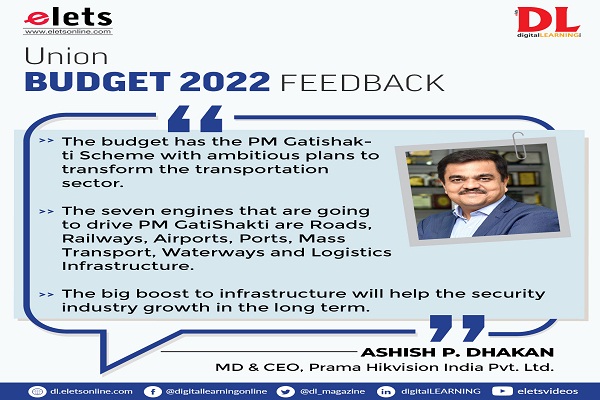Q – How do you see the use of technology, specifically digital technology, in the last two years?
A – The present time has been labeled as the digital age where information technology has led to considerable shifts in major sectors like education, services, work, and business. Speaking about higher education, the digital revolution has resulted in a position where access to universal knowledge is no more an issue. The current development of higher education to achieve the intended gross enrolment ratio has led to evolving e-learning videos with the help of digital technology.
The extensive reach of the internet, smart gadgets, and tools for digital access to learning resources has become the new normal as it brings learning material to the learners. The four-fold impact of e-learning at the global as well as local level is the new way of learning which will stay for a long time. The learner’s feedback on the use of various digital learning modules implies that digital learning has increased student-teacher engagement considerably. Additionally, it has led to hustle free access to learning materials and content which has successively led to improvement in overall student performance. Though the effectiveness of digital learning platforms strictly depends on the availability of content, quality of content, and internet speed.
Q – Do you think that the education sector has been able to sail through even during the pandemic because of the active use of technology?
A – The government rolled out a new National Education Policy (NEP 2020) that emphasises on digitisation in addition to using technology for imparting education. This was done to take education across the length and breadth of the country. Also, we are witnessing the era of Industry 4.0 where the use of digital services, internet is increasing every day. The pandemic has further escalated the adoption of technological services across all sectors including education in general and higher education is no exception to it.
With the onset of technological innovations, the education sector turns out to be the most affected. The new age technology has revamped the entire education sector. The digitally reinforced classrooms have made education accessible for all despite the difference of time, location or even subject. Another add-on that comes with the active use technology is the strength of classroom, as any number of students can access the virtual classrooms. When it comes to learning, unlimited knowledge can be availed at a feasible price. And not to forget, same topic or chapter can be accessed any number of times.
Active use of technology and its ramifications are in abundance in the education sector. Though, over the last two years, there has been a total paradigm shift in the entire education system. Education sector with the active use of technology has been sailing smoothly with obvious highs and lows and is here to stay.
Q – In the last two years, we have seen a boom in the use of technology to conduct online classes. Do we see online model replacing physical class model now?
A – Gone are the days when learning was limited to physical classrooms. The active use of technology has opened learning avenues and that too with the click of a button. Technology has aided and improved learning with the advantage of the learner’s convenience. The world today has become a classroom with the dawn of technology, building educational platforms which see lakhs of subscribers daily. Some of these subscribers use these platforms to boost their traditional classroom learning while others use such platforms to learn a new skill and to their existing skillset.
The pandemic has turned the education sector upside down as educational institutes unwillingly shifted to the online learning mode. This led to an increase in the adoption of technology as remote and virtual learning has become a substantial part of the learning ecosystem. The multiple benefits and various advantages of online classes are now well known which implies that online classes are here to stay. With the boom in technology adoption for imparting education, it is evident that online classes will make a positive impact. The use of digital tools and technology can complement and add value to physical classes. However, the shift to online classes has several basic drawbacks, which make it doubtful that online classes will replace physical classes any time soon.
It is high time to have the best of both worlds which can be achieved with blended learning. It is a mixture of both online and physical classes which is steadily being adopted across higher education institutes. It is a basic concept that resorts to a blend of trainer-driven physical classes and self-sufficient learning via online classes.
Q – There is a strong demand to make curriculums industry ready and, enabler to create more job givers than job seekers. Your view on that.
A – As per the eighth edition of the India Skills Report 2021, the unemployability percentage amongst Indian youth is around 54.1%. However, in situations where there are ample job opportunities, there is a lack of graduates with industry-relevant skills which also results in a soaring trend of unemployment. This can be associated with an expanding skill gap in the Indian ecosystem of higher education.
As workplaces and jobs are changing at a brisk pace, graduate skill sets must be boosted rapidly to meet industry demands. There is a continual argument about India’s educational institutes that produce unemployable graduates. This is a reality that cannot be overlooked as it reveals the existing gap between what the industry expects and what is taught. Normally, there is a mismatch between the curriculum that is taught in colleges, universities and what the current job requirement is. Earlier, the academic institutes designed their curriculum without any recommendations from the industry.
To settle out and fill this gap, the institutes need a dynamic association between the industry and the universities which will help make the students industry ready and eventually employable. This will improve the employability rate and help the industry at the same time. Higher education must be adapted to fulfill the industry requirements to create more job givers than job seekers in the country
Considering the IT Industry particularly, in the last decade it has witnessed explosive growth and this trend is expected to continue. This sector was somewhat unorganized as people polished their existing skills on the job. But the organizations can’t hire untrained talent and then invest time to train them and make them job-ready. This is now a trend across all sectors as head-hunters now want skilled and competent aspirants. The industry-academia partnership assists the students as they learn to strike a balance between technical and managerial skill set. Another aspect of this industry-academia partnership is the faculty who are a correct combination of academics and industry so that the students get the best of both worlds. Quality education, practical exposure via internships at the college level will aid in the performance improvement of the students and apply the gained knowledge practically to extract expected results.
Q – Do you think digital technology has shrunk the world and brought the best mentors closer to the students, bridging the barriers?
A – Digital technology has slowly and gradually made its way into the education domain while revamping the teaching-learning process globally. It has changed the world and has a positive impact on the modes of virtual communication, thereby reducing the world to an international village by empowering individuals to communicate smoothly and swiftly. Distinguished progress, a thriving tech investment, and the adoption of digital technologies during the pandemic are joining hands to raise hopes of a new era of development.
Talking about the education sector, digital classes have taken over the traditional and physical modes of education. The pandemic has had an impact on the entire education sector. This change like any other change has its pros and cons. Virtual classes have shrunk the world and brought the best of mentors, teachers, professors, and trainers closer to the students. The testimony to the above statement is that earlier attending a masterclass from a professor emeritus was a tough ask. But thanks to digital technology, students can easily learn from the best teachers just with a single click and access to world-class education despite geographical and linguistic barriers or accessibility needs.
Q – Lastly, what is your opinion about making education more future ready through more use of technology?
Looking towards the future is part and parcel of the life cycle, whether we are ready for what it would bring or not, we all count on the future. It is no surprise that we are presently living in a digital age and to accept a future-ready education in our aspirations is to consider technology for our growth plans.
For education to be future-ready, it is imperative that it is technology-driven. For students to be successful they should be facilitated with the necessary skillset, information, and knowledge that will help them traverse the continuous breakneck changes in the world. Education when fused with technology will help create a futuristic and unbiased learning ecosystem. Educators around the world are using the potential of technology to derive better student-teacher participation, develop contemporary ways of learning, and revamp the learning experience for students. This will result in preparing a future-ready workforce for the new world of work.
The education sector in India showed excellent coordination and flexibility during the pandemic. In short, technology has time and again changed the dynamics of education and will continue to make it future-ready and empowering a digital future.
Dr Prasheel Suryawanshi, VC, Avantika University










